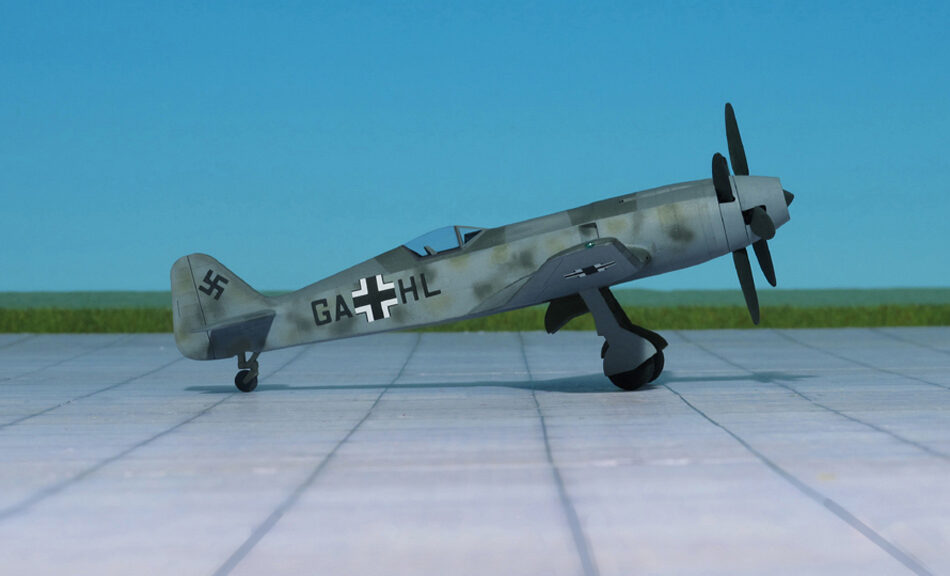TYPE: High-altitude Interceptor
ACCOMMODATION: Pilot in pressurized cockpit
POWER PLANT: One BMW P.8011 radial engine with two turbochargers, rated at 2.900 hp
PERFORMANCE: 451 mph in 26.215 ft
COMMENT: By the beginning of 1942, the Focke-Wulf Fw 190A was established in production and service, and most of the more serious shortcomings that has revealed themselves during the fighter’s gestation had been ironed out. A solution had still to be found out. However, the performance of the aircraft at high altitudes was inadequate. So one of the preproduction airframe was fitted with a nitrous oxide injection or GM 1 system for use above the rated altitude of the engine. The nitrous oxide, which was retained under pressure in liquid form in a tank aft of the cockpit, provided additional oxygen for the engine, but sometimes also acting as an antidetonant.
Flight testing proved disappointing. Effective combat altitude was boosted to some 26.000 ft, but insufficient nitrous oxide could be carried to increase power for more than brief periods, difficulties were experienced in lagging the pipelines, and the weight of the system, with its compressed air cylinders and heavily-lagged GM 1 tank, was almost as much as the total gun armament of the standard fighter.
Focke-Wulf was convinced that the desired performance could not be achieved with the BMW 801, and that the engine should be replaced by a liquid-cooled power plant. The design team with Prof. K. Tank favored the Daimler-Benz DB 603, but this engine was viewed with disfavor by the RLM, having been developed by Daimler-Benz without official sanction. Tank was informed that the improved performance now being sought should be achieved with developments of the BMW 801 air-cooled radial.
Meanwhile BMW was working on the BMW 802, a large air-cooled radial engine consistig of two rows of nine cylinders. It was essentially an 18-cylinder version of the 14-cylinder BMW 801. The BMW 802 emerged with an almost identical displacement to the American 18-cylinder Wright R-3350 Duplex Cyclone and somewhat larger than the British Bristol Centaurus. Although promising at first, development dragged on and the project was eventually cancelled.
Another idea to improve the performance was to bolt two BMW 801s back to back. Although seemingly a simple concept, the resulting, 83.5 litre displacement BMW 803 was in fact fantastically complicated. The power of the engine could only practically be used in extremely large propellers, or, as selected, a contra-rotating pair of propellers. This required a large gearbox on the front of the engine, which combined with the layout of the cylinders, left no room for airflow over the cylinders. This demanded the addition of liquid cooling.
Based on this concept of a twin-engine a further improvement led to the BMW P.8011. This engine was, able to produce 2.900 hp at take-off. The supercharger was replaced by two gas turbines enclosed in an aerodynamic engine cowling and driving two contra-rotating three-bladed propellers.
These engines were too heavy and powerful for the standard Focke-Wulf Fw 190 airframe. It was necessary to design a heavier airplane. The answer was a 125% scaled-up version of the Fw 190 with a wing of 42,7 ft span ad 371 sqft surface. The BMW P. 8011 was 38.7 ft long and the maximum weight was more than 11.900 lbs.
This new fighter was provided with an armored pressure cabin and used as high-altitude interceptor. Due to the war situation the project was cancelled in late 1944.
This monster fighter lacked any official designation and was only known as “Focke-Wulf Einsitzer mit BMW P.8011” (Focke-Wulf Single-seater with BMW P. 8011). By the end of 1944 in an article by General “Hap” Arnold, USAAF, published on 29 May 1944 in “Aviation News” refers it as Focke-Wulf Fw 290. But that is an error because the RLM Number “290” was given to the Junkers Ju 290 four-engine maritime control and transport aircraft (Ref.: 7, 24).

















